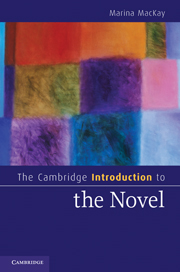Book contents
- Frontmatter
- Contents
- Acknowledgments
- About this book
- Chapter 1 Why the novel matters
- Miguel de Cervantes, Don Quixote (1605, 1615)
- Chapter 2 Origins of the novel
- Laurence Sterne, The Life and Opinions of Tristram Shandy, Gentleman (1759–67)
- Chapter 3 Narrating the novel
- James Hogg, The Private Memoirs and Confessions of a Justified Sinner (1824)
- Chapter 4 Character and the novel
- Nathaniel Hawthorne, The Scarlet Letter (1850)
- Chapter 5 Plotting the novel
- Gustave Flaubert, Madame Bovary (1857)
- Chapter 6 Setting the novel
- Charles Dickens, Bleak House (1853)
- Chapter 7 Time and history
- Virginia Woolf, To the Lighthouse (1927)
- Chapter 8 Genre and subgenre
- Graham Greene, The Ministry of Fear (1943)
- Chapter 9 Novel and anti-novel
- Thomas Pynchon, The Crying of Lot 49 (1966)
- Chapter 10 Novel, nation, community
- Salman Rushdie, Midnight's Children (1981)
- Chapter 11 Concluding
- Notes
- Glossary
- Further reading
- Index
- Cambridge Cultural Social Studies
Thomas Pynchon, The Crying of Lot 49 (1966)
Published online by Cambridge University Press: 05 June 2012
- Frontmatter
- Contents
- Acknowledgments
- About this book
- Chapter 1 Why the novel matters
- Miguel de Cervantes, Don Quixote (1605, 1615)
- Chapter 2 Origins of the novel
- Laurence Sterne, The Life and Opinions of Tristram Shandy, Gentleman (1759–67)
- Chapter 3 Narrating the novel
- James Hogg, The Private Memoirs and Confessions of a Justified Sinner (1824)
- Chapter 4 Character and the novel
- Nathaniel Hawthorne, The Scarlet Letter (1850)
- Chapter 5 Plotting the novel
- Gustave Flaubert, Madame Bovary (1857)
- Chapter 6 Setting the novel
- Charles Dickens, Bleak House (1853)
- Chapter 7 Time and history
- Virginia Woolf, To the Lighthouse (1927)
- Chapter 8 Genre and subgenre
- Graham Greene, The Ministry of Fear (1943)
- Chapter 9 Novel and anti-novel
- Thomas Pynchon, The Crying of Lot 49 (1966)
- Chapter 10 Novel, nation, community
- Salman Rushdie, Midnight's Children (1981)
- Chapter 11 Concluding
- Notes
- Glossary
- Further reading
- Index
- Cambridge Cultural Social Studies
Summary
Early in Pynchon's reworking of the detective novel, the suburban housewife Oedipa Maas learns that she has been assigned the task of executing the will of a former lover, the real estate mogul Pierce Inverarity. This daunting task will soon be dwarfed by a greater source of bafflement: Oedipa may have stumbled upon an ancient postal conspiracy stretching across two continents, from dynastic medieval Europe through a seemingly historyless modern California. But does the Tristero postal system really exist? Or is Oedipa losing her mind? Or is this a massive hoax orchestrated by the dying trickster, Pierce? Oedipa never finds out – nor do we.
The southern Californian setting of Pynchon's novel evokes the famous Los Angeles novels of Raymond Chandler, whose private eye can be counted on to get to the bottom of even global conspiracies. Pynchon's rewriting of a populist form, the detective novel, is an exemplarily postmodernist strategy, bridging the divide between high and low art. Such rewritings can produce pure kitsch, Pynchon announces at the outset, when Oedipa recognizes the muzak in the supermarket as “the Vivaldi Kazoo Concerto,” high art (Vivaldi) bathetically rendered in a vulgar medium (the kazoo, of all absurdities), but The Crying of Lot 49 will show that rewriting can also be more productively transformative, turning the familiar challengingly unfamiliar. That detective fiction is Pynchon's source is particularly significant because this is the genre most concerned with the exposure of secrets by solitary human ingenuity.
- Type
- Chapter
- Information
- The Cambridge Introduction to the Novel , pp. 159 - 161Publisher: Cambridge University PressPrint publication year: 2010

